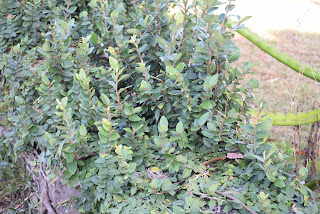 |
Banyan tree / Aiea Heights area / April 2016 |
The profuse greenery in Hawai’i very often makes it seem like we are in a jungle in the middle of suburbia! Some of the many trees with fascinating root systems and the over abundant vines are transplants from countries traditionally known for jungles.
There are many members of the Ficus (or fig) genus which are now a recognizable, and beloved, part of Hawai’i’s landscape. The most predominant one is the Banyan tree. A magnificent example is the block-large Banyan tree in Lahaina, Maui.
 |
| Rubber tree / Moanalua area / May 2016 |
There are also many stories about Princess Ka`iulani and a Banyan tree. I thought the latter was at Iolani Palace. But as I have frequently found in my blogging I learn something new and fascinating every week! The original Ka`iulani Tree (Chinese Banyan) was located in Waikiki and could not be preserved.
It was the first Banyan tree to be planted in Hawai’i. Here are two short articles and even a long scholarly paper all about Princess Ka`iulani and “her” banyan tree! Also just recently, the closest relative to the Ka`iulani Tree was set on fire! Here is an article about that tragedy.
 | |
|
With the Banyan tree’s amazing roots, it can also strangle a tree! If you drive to the North Shore you can see many palm trees (near the horse ranch), that are and have been overcome by the Banyan tree, whose seeds can lodge in the little pockets that make up this particular palm trees bark.
Trees grow on, and over, other trees. The first one is not a Ficus. The second is and is perhaps a Strangler Fig!
 |
| Octopus Tree on an Albezia / Aiea Heights area / May 2016 |
 |
| Fig Tree and roots on another tree / Aiea Heights area / May 2016 |
With Hawai’i's frequent rains and the predominantly sun-filled days (long growing season) plants turn into their most healthy, and thus developed, form. But what is healthy for a plant can be bothersome and destructive to humans! Especially those of us who appreciate plants that are native to Hawai’i or plants that are cultivated and controlled. Many ornamental vines, and other plants, have outgrown, and sometimes smothered, native plants!
Overgrown vines can become a weight burden to their “host.” Here is where the plant and humans are at cross purposes. The plant is merely developing to its full potential! The vine grows high up the trunk allowing it to get the most sun possible. Have you ever seen a succulent vine? This may be
Night-blooming Cereus.
 |
| Succulent vine / Moanalua area / May 2016 |
 |
| Eucalyptus trees with Pothos / behind our house / May 2016 |
Many years ago one of these Eucalyptus tree’s branches fell onto our house!
It has always amazed me how the pleasant house plant, Golden Pothos grows into hearty vines with huge leaves! A mistake occurs when a landscaper uses the Pothos as a ground cover and then the vine is not controlled.
 |
| Golden Pothos / Aiea Shopping Center / April 2016 |
 |
| Palm with Pothos / Aiea Shopping Center / April 2016 |
Some vines do not have as dramatic an effect. Two unusual things can occur with overgrown vines. Firstly, you may think the plant is something different as when I saw these pretty bushes with purple flowers only to realize the weedy vine was overtaking Hibiscus bushes.
 |
| Weed vine on Hibiscus / Pearl Harbor area / May 2016 |
In college, I learned that fully grown vines have made botanists misidentify the juvenile (low lying) and adult (upright) plant as two different plants. Look how these untrimmed pretty wall-covering vines transform, as an adult, to an upright plant.
 |
| Unknown vine (juvenile) / on wall Aiea Heights area / April 2016 |
 |
| Unknown vine (adult & juvenile) / Aiea Heights area / April 2016 |
Continue to “watch out for nature” and see how many roots and vines you can see in their full glory of growth!
No comments:
Post a Comment